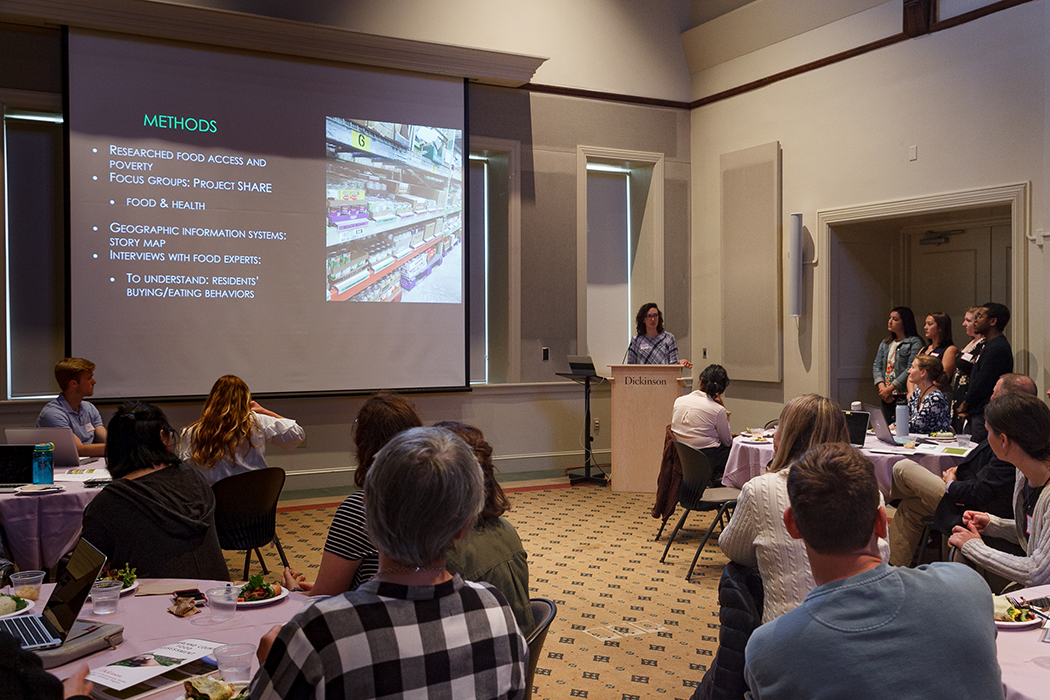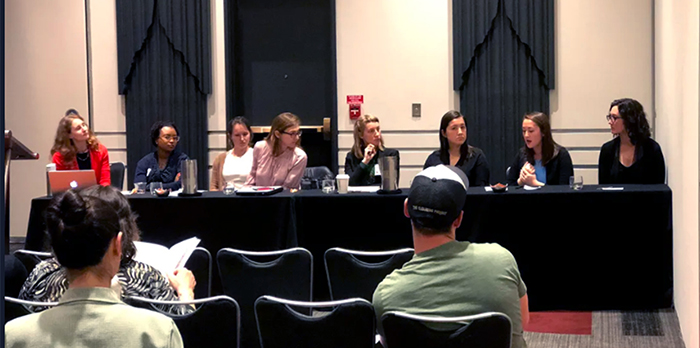Dickinson College Students Present High-Level Research on Food Security, Sustainability

On April 26, students delivered a lunchtime presentation on food security in Central Pennsylvania to community leaders. Photo by Carl Socolow '77.
Student-researchers make recommendations, create valuable resources
by MaryAlice Bitts-Jackson
Many Americans—including those in Carlisle and surrounding communities—do not have reliable access to the quantity and quality of food they need. That leads to increased reliance on food-assistance programs, poor health and developmental outcomes, reduced life expectancy and chronic stress. And nonprofits are looking for new ways to address this complex constellation of concerns.
Throughout the spring semester, Dickinson College students documented and analyzed the contributing factors to sustainability, food access and poverty in Central Pennsylvania. Now, they’re presenting their data and recommendations in public presentations, a full-color report and an online GIS map.
Drilling down
The students are enrolled in Assistant Professor of Environmental Studies Heather Bedi’s food studies/environmental studies course, Food, Poverty and Place. Their project is supported by a Mellon Foundation Grant for Civic Engagement awarded to Dickinson in 2016.
Environmental-studies majors August Andrews ’18, Nina Bethel ’20, Teressa Healy ’20, Olivia Kubaska ’20, Rachel Lapp ’18, Tom Riordan ’20, Natalie Smith ’18 and Kate Tanabe ’18 enrolled in the course along with Henry Cohen ’20 (political science, Spanish), Meggie Devlin ’19 (environmental science), Kayla Kahan ’18 (environmental studies, sociology), Madigan Kay ’18 (Italian studies), Kristen Kozar ’10 (political science, Spanish), Muhajir Lesure ’20 (environmental studies, philosophy) and Julia Mercer ’18 (environmental studies, women’s, gender & sexuality studies). First, they researched demographics, food insecurity, poverty and agriculture in the local community. Bedi co-organized an on-campus panel on local food insecurity, along with the Clarke Forum for Contemporary Issues, to connect students with those on the front lines of the fight.
Working collaboratively with local nonprofits, the students then interviewed community members working in the food, economic, employment and nonprofit sectors and conducted focus groups with food-insecure community members, centering on food access and health considerations. Then it was time to synthesize and analyze.
“The better we understand food insecurity, the better we can address these complex issues,” said Smith, who was surprised to discover that despite high income levels in most of the small river-bordering towns near Harrisburg, New Cumberland, Pennsylvania, emerged as one of three food deserts in Cumberland County, along with Carlisle and Shippensburg.
Sharing their findings

In early April, three students presented original research at a professional anthropology conference. Photo courtesy of Heather Bedi.
In early April, Bedi, Kay, Lapp and Tanabe traveled to Philadelphia to serve on a panel discussion, “Innovative Ways to address Food Security,” as part of the Society for Applied Anthropology’s Community Day annual meeting.
The April 26 full-class presentation, held in the Stern Center Great Room, attracted more than 35 professors, administrators and community leaders. After outlining the big picture, the students provided the stats on local food deserts; grocery stores, supermarkets and alternative food sources; farming; and food-assistance benefits and related charitable programs. They then recommended mentoring, training and pathways programs to help improve the lives of food-insecure persons and families, and also made a data-backed argument advocating for an increased federal minimum wage.
Each audience member took home a 39-page, full-color written report and an accompanying GIS map, displaying place-based information about incomes, availability of produce, grocery-store and farm-market locations and more.
“We’re really trying to drill down and understand all of the dynamics of food systems, so it’s nice to be able to flip through all of the tabs and access the most relevant data at this point in time, all in one place,” said Gail Witwer of the Partnership for Better Health (PBH).
“The quality of work is extraordinary,” added the PBH’s Becca Raley ’94, “and I’m so impressed by the expanse of analysis. It gives us much to work with.”
TAKE THE NEXT STEPS
Published April 30, 2018